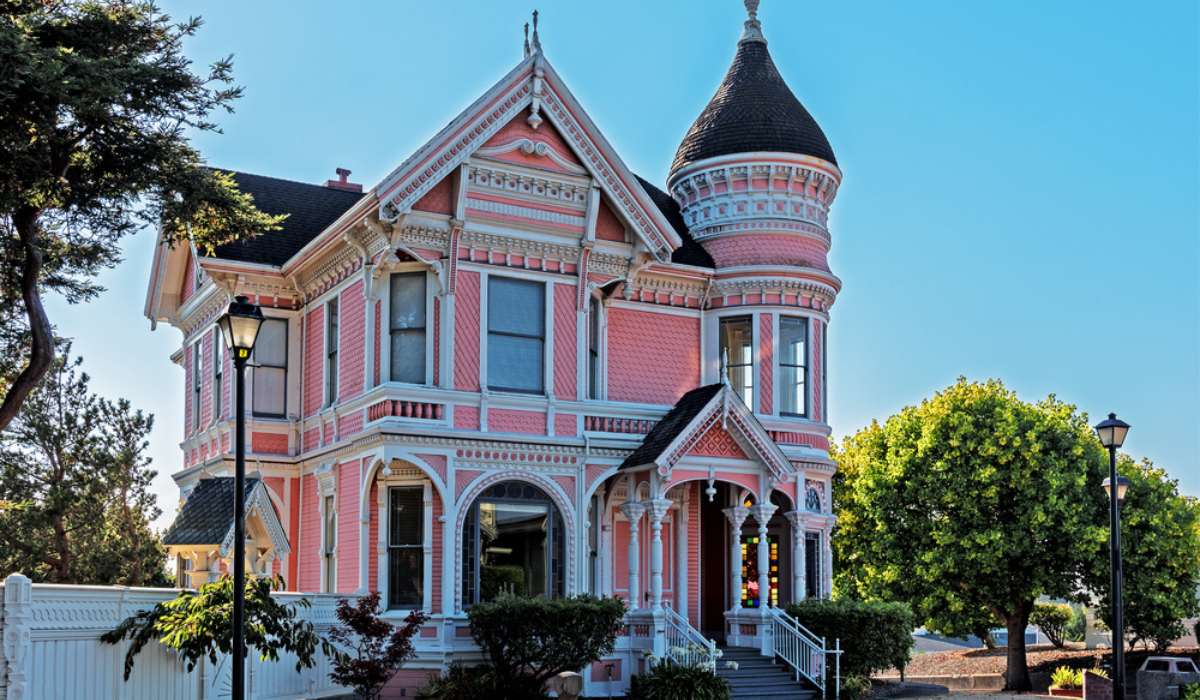Since more than 200 years ago, Victorian houses have won our hearts. Behind those dollhouse-like exteriors, there is much more than greets the sight. This architectural style has numerous distinctive variations, which need close examination. So what makes the Victorian home style so unique, and how has it evolved into a social trend? In all their apparent heterogeneity, these charming buildings have one thing in common. There is never a manque of character, whether they are restored to their pristine original state or reconstructed in a more modern style for contemporary needs.
Victorian-style homes, whether they are grand majestic palaces or quaint, charming cottages, provide occupants with an opportunity to inherit a relic of history, which is something you do not get in contemporary residences.

Source: Pinterest
History of the Victorian house
Victorian houses, as their name suggests, are depictions of well-known architectural designs from the time of Queen Victoria (1837-1901). Many of the characteristics we now associate with this style are fusions of earlier architectural styles like Romanesque and Medieval Gothic. Victorian architecture is prevalent due to the magnitude of the British Empire during the period. There are traces of this design all over the UK, North America, Australia, and New Zealand. Many aspiring architects would migrate to the provinces during this time to launch their careers. Surprisingly for us, though, they were able to keep up with the latest modifications in the Empire through a trading publication called The Builder.
Where to find Victorian houses today?
You can still find homes from the Victorian era in the US, Canada, the UK, and Australia. Around one in every six homes in the UK is a Victorian-style home. However, many Victorian homes in the US were destroyed in the name of urban renewal beginning in the 1950s. Even still, there are still millions of these houses, and the people who reside in them have become accustomed to their quirky, old-fashioned features.
Compared to the materials used in new construction today, the materials used to build homes during the Victorian era were of higher quality. Even after many decades of exploitation or neglect, these materials can frequently be brought back to their former state of functionality and beauty. However, any ancient property requires a lot of maintenance, so it’s critical to understand the background of the house. This may entail dealing with harmful chemicals, replacing mechanical systems for convenience and efficiency, and adhering to local building rules and heritage conservation laws.
Victorian house: Types
There is a certain variation in style as a result of these geographical distinctions. The most popular styles of Victorian houses are listed below:
1. Gothic Revival (1830-1860)
Houses built in the Gothic Revival style are frequently compared to castles since European mediaeval cathedrals influenced them. Their distinctive features stand out because of their steeply pitched roofs, pointed arches, and front-facing gables that are adorned with vergeboards, a delicate wooden trim.
2. Italianate (1840-1870)
These houses, usually two stories, were designed after Italian Renaissance villas. They have low roofs and wide eaves in juxtaposition with other Victorian architectural forms. However, they also feature ornate brackets in keeping with this architectural style.
3. Second Empire (1852-1870)
The time of Napoleon III in France served as a major source of inspiration for this design. These houses often have a simple rectangle or square basis. This house design holds plenty of character in itself, though. They have mansard roofs, which have a steep pitch on all four sides, and a lot of detailed exterior woodwork.
4. Stick-Eastlake (1860-1890)
These houses can be identified by the fact that they are predominantly constructed of wood, which was an affordable and easily accessible resource during their era. These houses have angled timber framework that is covered in what is known as “stick work”. In addition, they often have double-hung windows and pitched, shingled roofs.
5. Folk Victorian (1870-1910)
Folk Victorians are smaller, squarer versions and have less intricate floor plans than the usual Victorian house. They are designed for common people. However, the ornamental trim work defining their porches and roof lines still displays their Victorian heritage. Look for bevelled corners, twisted spindles, and lace-like details.
6. Queen Anne (1875-1905)
Queen Anne is arguably the most well-known of all Victorian designs. These buildings, which were constructed later in Victoria’s reign, have particularly elaborate architecture, gabled roofs, rounded towers, and sizable windows that serve both utilitarian and ornamental purposes.
Victorian house: Features
While different architectural styles have predominated at different times in history, some common traits unite them all.
- Usually two to three stories tall, the homes have steeply gabled roofs and circular turrets.
- Inside, it’s typical to find closed-off chambers, extra nooks, high ceilings, and irregularly shaped walls.
- These houses were distinguished by elaborate trim work, which included gilded wainscoting, extravagant fireplace mantels, and exquisite wooden staircases.
- The hallmark of a Victorian house was a glistening chandelier since the Victorians were recognised for their love of grandeur above all else.
- To draw the viewer’s attention to the top of the house, architects incorporated towers, turrets, and dormers into the exterior of the building.
- The distinctive stained glass, beautiful woodwork, and vibrant colour schemes are also indisputable. They are frequently framed by a wraparound porch embellished with gingerbread cutouts and spindle work.
- In terms of design, an open layout concept was unimaginable at that time.
- There was a parlour where people hosted guests, a music room where they played the piano, and a library where you could read.
- Because of this, these residences frequently have intricate floor plans and complicated interiors that are typically meandering.
- Despite the wide variety of Victorian house designs, this architectural style is united by a few distinguishing characteristics.
This is generally what to expect, even though not all varieties may fit into each factor:
Exterior of a Victorian house
- Steep, gabled roofs
- Round angles
- Towers, turrets and dormers
- Shapely windows, especially bay windows
- Stained glass
- Decorative woodwork
- Bright colours
Interior of a Victorian house
- Two to three stories
- Floorplans featuring added nooks
- High ceilings
- Intricate wooden trim
- Ornate staircases
FAQs
What characteristics do Victorian houses have?
The Queen Anne style is arguably the most well-known of all Victorian designs. These buildings, which were constructed later in Victoria's reign, have particularly elaborate ornamentation, gabled roofs, rounded towers, and sizable windows that serve both functional and ornamental purposes.
How sturdy are Victorian houses?
They are durable, well-built, and well-designed buildings since they are still standing.
Housing News Desk is the news desk of leading online real estate portal, Housing.com. Housing News Desk focuses on a variety of topics such as real estate laws, taxes, current news, property trends, home loans, rentals, décor, green homes, home improvement, etc. The main objective of the news desk, is to cover the real estate sector from the perspective of providing information that is useful to the end-user.
Facebook: https://www.facebook.com/housing.com/
Twitter: https://twitter.com/Housing
Email: [email protected]











